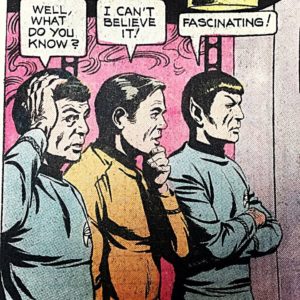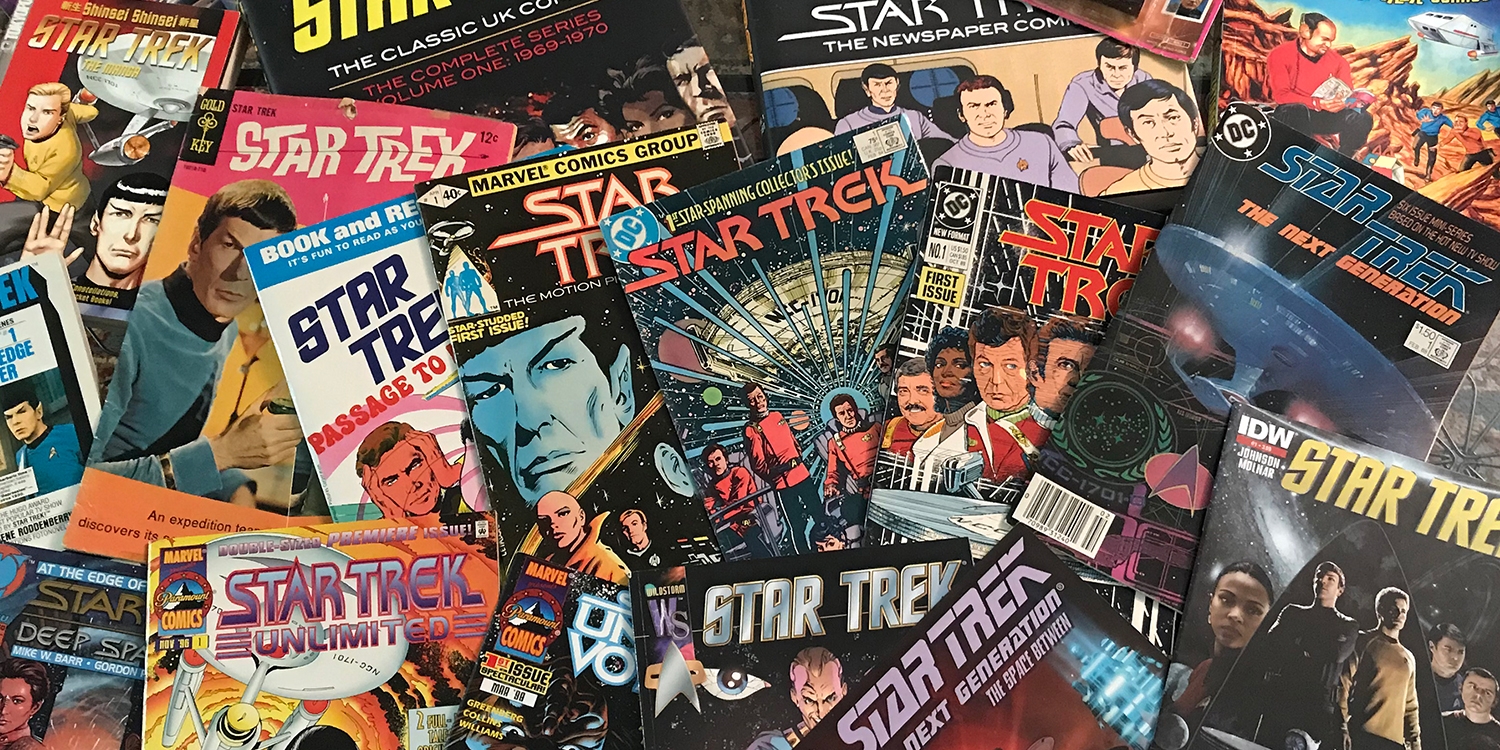Dear reader,
I’ve been called on my shit and must react in kind. In a Women At Warp episode recorded earlier this year, we were asked for our must-reads of the world of Star Trek comics. While no one has ever been able to isolate the sound of a deer’s eyes widening in the headlights, I’m pretty sure you hear it when the question is tossed to me as a resident “comic expert.”
The sad truth is that my exposure to the comics world of a half-century long franchise consists mostly of either a) reviewing recent series or b) “look at this weird panel from the 60’s where Scotty is drawn cross eyed but has long luscious eyelashes!” This was a moment of truth where I had to admit that in two-realms of “know-it-all”-ery, at their crossroads I was only a “kinda-know.” This could not stand.
Not being able to find a comprehensive list of recommendations that spanned the full width of Star Trek to my satisfaction, I decided I’d set out and make a list of my own. That was six months ago. Needless to say, after looking up the sheer number of comics I’d need to wade through and put out a critical two cents on had me a little spooked. Plus having seen comic discourse play out with the social media bloodbath of a Peckinpah movie (if Earnest Borgnine had a collection of bizarrely specific crossover shirts) would have anyone a little wary. But no more! It is time to jump feet first into this pool of unknown depth that more than likely has some algae chunks floating around. Into thee I dive, in search of what wonders may have sunk to the bottom in obscurity (Hidden treasure? Half a pool noodle? Maybe somebody’s lost retainer?).
Before proceeding I’ll need to develop a critical grading rubric against which to compare all measured works. A good standby and critical rule of thumb is Goethe, who categorizes criticism as being either destructive or constructive. “Destructive” is an easy one to suss out (as anyone who’s ever been cornered by a guy with an opinion on Ghostbusters can tell you) but he describes it as “one need only set up some imaginary standard, some model or other, however foolish this may be, and then boldly assert that the work of art under consideration does not measure up to that standard, and is therefore of no value.” Constructive criticism is meant to ask “What did the author set out to do? Was his plan reasonable and sensible and how far did he succeed in carrying it out?” (Granted this is all the opinion of Mr. Johann Wolfgang “500+ pages of hammering home that Satan = Bad” von Goethe so there’s got to be a few grains of salt there.)
So setting out the big question is “Where to plant the fence between destructive and constructive?” and then more specifically “How do we apply this to 53 years worth of Star Trek comics?” And that’s where we meet our grading rubric. I’ve broken down my primary criteria for critical comic and/or Star Trek evaluation into the following categories which can each be graded on a scale of -10 to 10:
- Writing: Do words good?
- Illustration: But is it art?
- Concept: what’s the big idea?
- Execution: Are we picking up what they’re putting down
- Coolness: Not so much “X-factor” as “F yeah factor”
- Whimsy: Does this spark joy?
- Kitsch: is it at least weird enough to be fun?
- Enrichment: Does it add anything worthwhile to the world of Trek
- Characterization: Is it on-brand?
- Usage of Medium: does it do something with this media format that couldn’t be done in another?
Once we have a metric of measurement in place we, like so many well-meaning teachers who came before, must divvy-up the assigned reading. In the interest of casting a wide net, the regular reading is going to need to span both the subject matter in the different series represented and the time in which the comic itself was produced. Each review will be of three separate works, from three separate decades, representing three different Star Trek properties. Why three? Because any more and we’ll risk establishing a third branch of criticism called “Grace is so maxed-out she’s started writing Digimon-based conspiracy theories in place of reviews”.
Will I succeed? Will I be overwhelmed by a comics creators trying to reinvent the wheel with an already beloved franchise? Will my failure be prodigious? Will the crew need to start keeping a tighter leash on my blog entries? Only God, Q, and my half-finished cache of article proposals know for sure.


BOLDLY GO WITH GRACE!
Good luck – I’m looking forward to reading the results